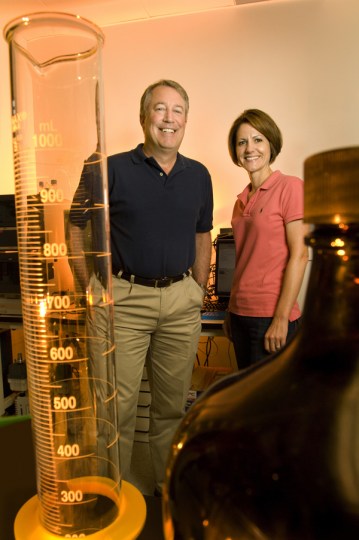
Daniel Liebler, Ph.D., Lisa Zimmerman, Ph.D., and colleagues are studying a new method for identifying cancer biomarkers. (photo by Susan Urmy)
Researchers build bridges to cancer biomarkers
A new method for detecting and quantifying cancer-associated proteins in body fluids may offer a major boost to the development of biomarkers to aid in early cancer detection and personalized cancer therapy.
In Nature Biotechnology, Vanderbilt-Ingram Cancer Center researchers and partners in the National Cancer Institute's Clinical Proteomic Technology Assessment for Cancer (CPTAC) program describe a combination of proteomics methods that increases accuracy and reproducibility of candidate biomarker verification, ensuring that the best biomarker candidates are carried through to clinical validation.
Although thousands of cancer biomarker candidates have been reported, only a handful have been clinically validated, largely due to lack of standardized technologies and methods for verifying those candidates.
“Despite broad enthusiasm for the potential of proteomics to identify cancer biomarkers, the reproducibility of the technology has been unclear,” said Daniel Liebler, Ph.D., Ingram Professor of Cancer Research, director of the Jim Ayers Institute for Precancer Detection and Diagnosis, and leader of the Vanderbilt CPTAC team.
A biomarker development pipeline encompasses a “discovery” phase, a “verification” phase and a “validation” phase that includes clinical trials. In the discovery phase, the process of “shotgun” proteomics compares tumors to normal tissue to identify proteins that distinguish cancers from healthy tissue, yielding dozens to hundreds of candidate biomarkers in each experiment.
“You start with a lot of possible molecules, and then you play molecule 'Survivor,'” says Liebler. “You eliminate the ones that are unfit for the purpose until you end up with a few molecules that have really good quality credentials.”
Normally, the narrowing down of biomarker candidates — the “verification” phase — is done with immunoassays, using antibodies that react with the candidate proteins in biological specimens. However, the supply of good quality antibodies for the vast number of biomarker candidates that come out of the discovery phase is inadequate, creating a broken link in the biomarker discovery pipeline.
“There is a need for a bridging technology in the middle of the 'pipe' that would allow you to sort out, evaluate and actually eliminate poor quality candidates,” he said.
The NCI established the CPTAC program to help evaluate the ability of proteomics technologies to serve as that bridge. Vanderbilt-Ingram was one of five centers chosen to participate in the effort. The study described in the Nature Biotechnology paper represents a two-year project done among the CPTAC centers. Lisa Zimmerman, Ph.D., research assistant professor of Biochemistry, led the work of Vanderbilt’s CPTAC team on the study.
The CPTAC teams focused on combining two existing mass spectrometry-based technologies that do not depend on antibodies — multiple reaction monitoring (MRM) coupled with stable isotope dilution mass spectrometry (SID-MS).
The purpose of the current study was not to evaluate specific cancer biomarkers, Liebler explained, but “to determine how the technology behaves in various people's hands, to see whether they could all 'sing in the same key.'”
The teams analyzed three sets of specimens — which consisted of human blood plasma containing either peptides that corresponded to seven proteins of interest, digested proteins, or the intact proteins. In a series of experiments, the teams showed that the SID-MRM-MS platform can consistently identify and measure candidate biomarkers across laboratories and that the degree of variation is on par with the performance of clinical assays.
“That was very encouraging because it suggests that you can implement an MRM-based technology in the middle of a biomarker development pipeline and use it across multiple laboratories to evaluate biomarkers,” Liebler said.
Implementing such methodology could provide a major advance to the development of cancer biomarkers, including blood tests for cancer detection. Having more cancer biomarkers available for clinical use could aid in early detection, help determine the likelihood of tumor recurrence, and help select more individualized cancer treatments.
The CPTAC teams are now refining the methodologies — making them more sensitive and configuring them to analyze dozens to hundreds of candidates in a single assay. The ultimate goal is to implement the process with real clinical specimens, with collection of samples currently underway at Vanderbilt-Ingram and the other centers.
Although the emphasis of the CPTAC program is on cancer biomarkers, the lessons learned and technologies developed will be broadly applicable to a range of human conditions.
“These methods are applicable not just to cancer but also to heart disease, diabetes, a lot of other things,” Liebler said.













